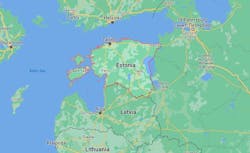Russian neighbor Estonia signs MOU with NuScale on feasibility of Small Nuclear Reactors
Another European nation which is moving away from Russian natural gas is now exploring the carbon-free potential of small reactor nuclear power.
Estonia’s Fermi Energia wants to explore small modular reactors (SMRs) in the nation that shares a lengthy border with Russia. Currently most of Estonia’s power generation is fueled by fossil resources such as coal and gas, but it wants to move toward stiffer carbon emissions reductions and may phase out Russia gas imports by the end of this year.
Fermi Energia has signed a memorandum of understanding (MOU) with SMR developer NuScale Power. Oregon-based NuScale recently gained U.S. regulatory approval to move ahead with projects based on its small reactor designs.
Under this new MOU, NuScale will support Fermi Energia as it conducts further analysis and considers deploying a NuScale VOYGR SMR power plant in country to meet clean, baseload energy needs by 2031.
“Considering the geopolitics of today, this agreement builds upon the existing momentum and strong interest from the international community,” said John Hopkins, NuScale Power President and CEO. “NuScale looks forward to working with Fermi Energia as they evaluate how our SMRs can become a key component of Estonia’s energy future.”
The company’s VOYGR SMR power plant configuration could employ as many as 12 of the 77-MW small reactors The reactors measure 65 feet tall by nine feet in diameter.
More on Nuclear's Future potential in the Mission Critical Energy Transition
Idaho National Lab report champions Small Nuclear for Fuel Security, Carbon Free attributes
NRC gives final certification approval for NuScale SMR design
Subscribe to EnergyTech's free, tri-weekly newsletter for more stories like these
The NuScale light water reactor has up to 24 months in its refueling cycle. It needs only about a 20th of the nuclear fuel size of the large reactors, according to projections.
Proponents say the SMR designs are smaller and less expensive to build than conventional nuclear power plants. Other companies working the small and advanced nuclear reactor space include X- energy and Terra Power, among others.
“The great advantage of the new generation of small modular reactors is clearly manifested in the case of Estonia. They fit better into the electricity grid, are more flexible and economical to operate, and meet stricter safety requirements than the existing nuclear plants,” said Kalev Kallemets, Fermi Energia CEO and co-founder. “Before choosing the most suitable technology for Estonia, we will conduct a comprehensive analysis and evaluate which of the small reactors that will become market-ready in the near future best meets Estonia's needs to produce CO2-free energy year-round, in any weather, at an affordable price.”
Poland also is studying the feasibility of SMR nuclear within its borders.
In the U.S. there are no small nuclear reactors in commercial operation yet. Overall, nuclear power plants generate about 20 percent of the nation’s electricity and more than half of its carbon-free power, according to the U.S. Energy Information Administration.
Estonia traditionally has relied on coal-fired power, oil shale and other fossil fuels. The northern European nation is considered one of the more advanced economies out of the countries occupied by the former Soviet Union until 1991.
It does have Russian natural gas pipelines within its boundaries.
-- -- --
(Rod Walton, senior editor for EnergyTech, is a 14-year veteran of covering the energy industry both as a newspaper and trade journalist. He can be reached at [email protected]).
About the Author
Rod Walton, EnergyTech Managing Editor
Managing Editor
For EnergyTech editorial inquiries, please contact Managing Editor Rod Walton at [email protected].
Rod Walton has spent 17 years covering the energy industry as a newspaper and trade journalist. He formerly was energy writer and business editor at the Tulsa World. Later, he spent six years covering the electricity power sector for Pennwell and Clarion Events. He joined Endeavor and EnergyTech in November 2021.
Walton earned his Bachelors degree in journalism from the University of Oklahoma. His career stops include the Moore American, Bartlesville Examiner-Enterprise, Wagoner Tribune and Tulsa World.
EnergyTech is focused on the mission critical and large-scale energy users and their sustainability and resiliency goals. These include the commercial and industrial sectors, as well as the military, universities, data centers and microgrids. The C&I sectors together account for close to 30 percent of greenhouse gas emissions in the U.S.
He was named Managing Editor for Microgrid Knowledge and EnergyTech starting July 1, 2023
Many large-scale energy users such as Fortune 500 companies, and mission-critical users such as military bases, universities, healthcare facilities, public safety and data centers, shifting their energy priorities to reach net-zero carbon goals within the coming decades. These include plans for renewable energy power purchase agreements, but also on-site resiliency projects such as microgrids, combined heat and power, rooftop solar, energy storage, digitalization and building efficiency upgrades.


